 |
Posted on 01/20/2004 7:24:59 AM PST by Maximilian
|
As soon as I heard of Ken Jones' Index of Leading Catholic Indicators,1 I had an intense desire to purchase a copy. The 113-page paperback book contains statistics relating to all aspects of Catholic life: Catholic education, religious orders, Catholic practice and belief, seminarians, nuns, and diocesan priests. Having read the Index, my compliments go out to Mr. Jones. Like myself, Mr. Jones is the father of seven young children, so I understand the sacrifice it was for him to take the time to bring this important information together. He has done an excellent job of presenting clear, irrefutable, unbiased, and undeniable raw data pertaining to the crisis in the Church, and he also provides some important analysis of that data. It is important work, and it is solid evidence supporting what many of us have known for a long time.
Poring over page after page of bar charts, graphs, and tables in the Index, one cannot help but be overwhelmed by the sense of loss. In every category — religious orders, diocesan priests, religious priests, teaching orders, you name it — the decline is sharp, obvious and undeniable.
Being a mathematician, however, I was not content to just read his book cover to cover. Mr. Jones' analysis was good, but he did not view his data the same way a mathematician does. Instantly I saw linear functions, exponential functions, and patterns that we can use to model and make predictions. The numbers, bar charts, figures and statistics gave me a level of excitement and an adrenalin rush that most would have to turn to bungee jumping to achieve.
At the sight of the tables of data, I reached for my computational tools: Maple 8.0, Sigma Plot, SPSS for Windows, and my trusty old Texas Instruments TI-85. Initially I was not sure where to begin, but after careful consideration, I concluded that the most important statistics are those having to do with seminarians. Seminarians are the future of the Church; without priests we will become a different Church. Godfried Cardinal Danneels of Belgium stated in an interview with the Catholic Times in May 2000 that "Without priests the sacramental life of the Church will disappear. We will become a Protestant Church without sacraments. We will be another type of Church, not Catholic." Already we can see this bleak prediction coming to pass as one parish after another is turned over to "Lay Administrators." So the chart having to do with the total number of seminarians2 throughout the better part of the last century is the most significant to us as Catholics.
Now, an initial glance at the bar chart titled "Total Seminarians" seems to indicate that there are essentially two functions: one linear and one exponential. The period prior to 1965 shows a linear increase and the period from 1965 to the present shows an exponential decrease.
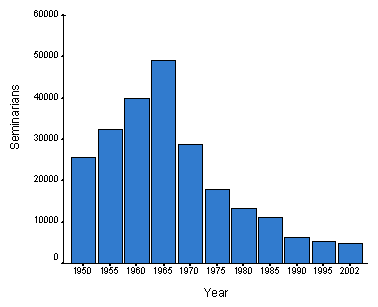
We begin our analysis by plotting the graph for the period prior to 1965. This period was one of steady growth, so I found that we could roughly match it with a line of slope 829.331. This means that each year that passed there were approximately 829.3 seminarians more than there had been the previous year. So every ten years there were approximately 8,293 seminarians more than there had been the previous decade.
The growth rate over this period can be expressed as P (for "Preconciliar Growth Rate") as a function of time t, where t is in years and t = 0 in 1920:
![]()
Or, expressed as a function of the year:
![]()
Where the value of year can range from 1920 to the year 1965.

The growth was actually not perfectly linear, as we can see; in fact it was beginning to accelerate into what appears an exponential growth in the final years from 1940 to 1965. However, let's assume the worst — that the growth had just continued at the linear rate described by P(year). Then the number of seminarians we could have had in the year 2003 would have been approximately:
![]()
So, had this growth rate continued, by the year 2003 we would have a total of approximately 73,927 seminarians instead of the current figure of less than 5,000. Below you will see the actual data, and superimposed on it is a projection of P(year), the Preconciliar Growth Function, extending through the year 2002.
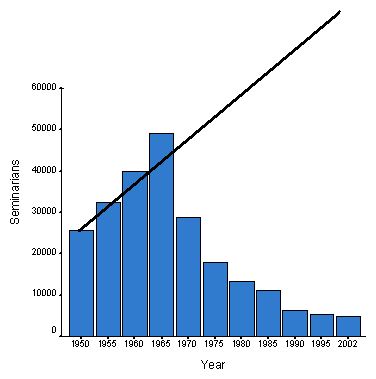
It is clear that the period from 1965 onward is nonlinear, so a different technique is required for modeling this period. The exponential decrease from 1965 onward appears similar to a graph of radioactive decay; as it turns out, this period can be modeled by what is commonly called an exponential decay function. Since this period of the Church is commonly called the "Springtime," we shall refer to this function as the Springtime Decay Function S(t), where S, the Springtime Decay, is a function of time t. We begin by taking the log of each of the data points. This gives us an essentially linear data set, to which we can match a line as we did previously for the Preconciliar Growth Function. Now we exponentiate both sides of our equation obtaining the following function:
![]()
Or, expressed as a function of the year:
![]()
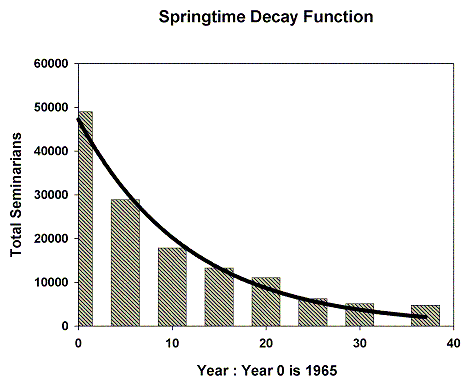
Applying this model we can see that by the year 2065, 100 years from the beginning of the Springtime Decay process, there will be a total of 10 seminarians in the United States. The half-life of this process is 8.19 years, the approximate period of time it takes for the number of seminarians to diminish by ½.
There are some who will argue that this model does not apply. The last two actual data points are higher than the exponential decay function; certainly, according to some, this means that the decline is over, and that all will be back to normal soon. This is wishful thinking, but to accommodate them we turn to the modified exponential decay model. The Modified Springtime Decay Function is not as simple, but it is more accurate:
![]()
Or, expressed as a function of the year:
![]()
According to this modified decay function there will be 779 seminarians in the year 2065 instead of the 10 predicted using the previous model.
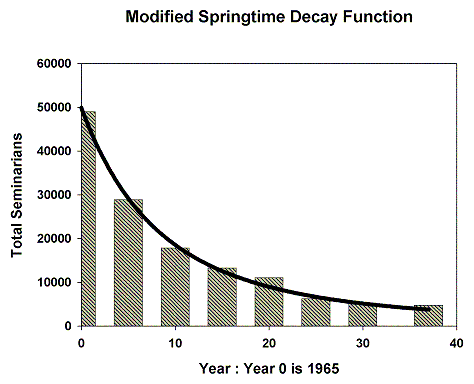
We can obtain a rough estimate of the number of lost vocations by taking the sum from 1965 to the present, in five year increments, of the difference between P(year) and S(actual), where the values for S come from the actual data in Mr. Jones' Total Seminarians table.
![]()
This estimate makes two assumptions:
We obtain the following values for each year:
| Year | P(year) | S(actual) | Difference |
|---|---|---|---|
| 1970 | 46,560 | 28,819 | 17,741 |
| 1975 | 50,706 | 17,802 | 32,904 |
| 1980 | 54,853 | 13,226 | 41,627 |
| 1985 | 59,000 | 11,028 | 47,972 |
| 1990 | 63,146 | 6,233 | 56,913 |
| 1995 | 69,293 | 5,083 | 62,210 |
| 2002 | 73,098 | 4,719 | 68,379 |
| TOTAL: 327,746 | |||
According to this rough estimate, approximately 17,741 vocations were lost over the first five-year period, 32,904 were lost over the second five-year period, etc., for a total of 327,746 since 1965.
There is no formula available for the calculation of the number of souls lost as a result of this loss of vocations.
There is one additional set of data that was not included in the Index, and that is data relating to the increasing number of vocations found through the "Traditional" Catholic seminaries, or those seminaries in which the 1962 rite is followed and priests are formed according to preconciliar standards. At the moment these seminaries are relatively new, but the growth is impressive. I was unable to obtain any statistics on the Institute of Christ the King, Sovereign Priest, which has a small presence in our country, but the figures for the graph below were provided courtesy of Fr. James Jackson, rector of Our Lady of Guadalupe Seminary in Denton, Nebraska. Our Lady of Guadalupe, where priests of the FSSP (Fraternitas Sacerdotalis Sancti Petri, or Priestly Fraternity of Saint Peter) receive their formation, is now in its twelfth year. Since their move from Pennsylvania to Nebraska four years ago they have been operating at maximum capacity. This fall, Academic Year 2003-2004, as in previous years, they had to turn away a large number of candidates due to lack of room in the partially completed seminary.
The noticeable gap at year eight was during their move from Pennsylvania to Nebraska.
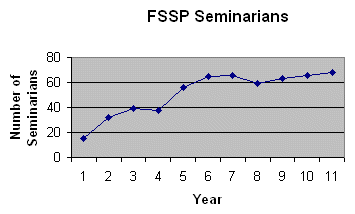
Many have asserted that the sudden decline in all aspects of Catholic life that began in 1965 was due to "other factors," such as the influence of "the sixties." But Mr. Jones soundly refutes that argument by including a simple chart3 which shows a marked decline in Church attendance among Catholics from the 1960s to the present while it remained virtually level, with a slight increase, for Protestants. To more fully understand the nature of the crisis we find ourselves in, I highly recommend that every Catholic capable of reading beyond an eighth grade level purchase a copy of the Index and study it.
It is clear from this brief analysis of the data relating to the number of seminarians over the past eighty years that several things are true:
Although we cannot know the will of God, we can ponder the significance of the following:
The author, a retired Lieutenant Colonel in the United States Army, teaches Computer Science and Mathematics at Lyon College in Batesville, Arkansas where he resides with his wife and seven children.
False. Start with faulty data and end with false conclusions.
Item. In the period 1950-1965, the vast majority of men entering the seminary were not ordained. All were pre-Vatican II ephemeral vocations.
Item. In the period 1985-2000, the majority of men entering the seminary were ordained.
Item. The article does not investigate the really meaningful numbers - annual priestly ordainations and defections. Perhaps because the decline in these numbers is not nearly so marked as the decline in seminarians, and thus does not make good copy?
Item. The numbers are not compared against other meaningful indicators as a ratio - Catholic male population age 20-25, percentage of Catholics counted attending Mass in annual October counts, etc.
Conclusion 1. The decline in seminarians was mostly a decline in the number of epehemeral vocations. The Catholic Church is now no longer wasting vast resources on the education of men for 1-3 years only for most of them to leave the seminary system.
Conclusion 2. The decline in ordinations mirrors the decline in Mass attendance - it is not as sharp as the decline in seminarians. Failing to lay out the facts along these lines provides a distorted message.
Conclusion 3. The Seminarian population is an outlier data set in the general malaise affecting the Church in America.
Concluson 4. The failure to take into account obvious factors and using the wrong data set shows an intention to promote an agenda rather than diagnose a problem.
Conclusion 5. The author and his source are dishonest at best.
Report on Africa
Peter Schineller, S.J. Introduction About 12% of the world's population reside in Africa, second only to Asia. In Africa we are witnessing the fastest growth ever in the 2000 year history of Christianity. Here are a few statistics to illustrate this point:
Former Dean and Professor of Theology, former Regional
Superior of the Jesuits of Nigeria-Ghana, and future Dean
and Professor of Theology at Hekima College, Nairobi
Population |
Catholics |
Seminarians |
|
| 1900 | 118 | 2.3 | ? |
| 1970 | 320 | 32 | 3,470 |
| 1997 | 720 | 95 | 19,000 |
Africa is large, containing 22% of the land of this good earth. Europe, the USA, India, China, and Argentina all fit within Africa. Africa is complex, with over 2000 languages and ethnic groups. For the purpose of this presentation, I am focusing on subSaharan Africa, and thus not speaking of North Africa or Egypt.
True. All of the data used in the article is accurate, so your comment doesn't apply here, however.
In the period 1950-1965, the vast majority of men entering the seminary were not ordained. All were pre-Vatican II ephemeral vocations.
Proof? Data? Numbers? Doesn't it seem ironic that you are attacking the reliability of hard numbers while providing no data of your own?
The article does not investigate the really meaningful numbers - annual priestly ordainations and defections. Perhaps because the decline in these numbers is not nearly so marked as the decline in seminarians, and thus does not make good copy?
What evidence do you have for that assertion? Here in our diocese the Catholic newspaper gives us a weekly dose of "reality" with statistics about the plummeting number of priests and the future of "priestless parishes." They have stopped putting on the happy-face pretense (that was phase 1 which is now over), and they have moved into the next phase in which they create a "new model of the Church" that includes only a handful of priests for the diocese. The reality right here on the ground is exactly what is demonstrated by these numbers.
The numbers are not compared against other meaningful indicators as a ratio - Catholic male population age 20-25, percentage of Catholics counted attending Mass in annual October counts, etc.
That wasn't the purpose of his article. Write your own article if you think you could do better. His purpose was to analyze the existing numbers for demonstrable trends within the data sets. This he has done admirably.
Conclusion 1. The decline in seminarians was mostly a decline in the number of epehemeral vocations.
Only a conclusion if you are the type to jump to conclusions without any evidence. You haven't demonstrated one shred of evidence for this assertion.
The Catholic Church is now no longer wasting vast resources on the education of men for 1-3 years only for most of them to leave the seminary system.
I don't consider that "wasting" at all. In fact, this was probably one of the best and most encouraging trends of the time period which was leading to a much more educated, involved, and spiritually active laity. Too bad this trend was hijacked by the revolutionaries in favor of false "involvement" and "activity."
The decline in ordinations mirrors the decline in Mass attendance - it is not as sharp as the decline in seminarians. Failing to lay out the facts along these lines provides a distorted message.
It's true that every data set is declining together. It's true that you could do the same sort of data analysis on all the different "leading indicators." But you are trying to create an implication of cause and effect where there is no evidence that it exists. Perhaps the decline in Mass attendance mirrors the fall of ordinations, not the other way around. Clearly all these indicators mirror the same fundamental causes.
The Seminarian population is an outlier data set in the general malaise affecting the Church in America.
Evidence? At least you admit the "general malaise." To what extent are the numbers for seminarians any different than all the other indicators? And which indicator will have the biggest domino effect? With no seminarians there are no priests and no holy sacrifice of the Mass, no matter how many people want to attend one on Sunday.
The failure to take into account obvious factors and using the wrong data set shows an intention to promote an agenda rather than diagnose a problem.
There are no "factors" to take into account. He is not proving a correlation. He is analyzing the trends that exist within the existing set of data. To call the data set "wrong" is just a presumptuous opinion with no factual basis.
Conclusion 5. The author and his source are dishonest at best.
If "patriotism is the last refuge of a scoundrel," then character assassination is the first refuge of the neo-Catholic apologist. You have no arguments so you attack the author. Someone is being dishonest here, but it is not the author of the original piece.
He didn't "omit any statistics." He analyzed the data that already exists regarding America, which is the country where he happens to live . By coincidence, I too live in America, and so does Kenneth Jones the author of the original book, and so do you, judging by your screen name. So why try to change the subject to a land far away where we have so little hard evidence? How about if we deal with the situation right here in our own country where we actually live?
And before we look to Africa to save the Church, perhaps we should consider a few facts. It's difficult to get hard data from Africa, but all the evidence that we do see indicates a continent returning to barbarity and chaos. A land where the most Catholic countries engaged in wholesale mass slaughter and genocide of millions within the past decade. A place which was the subject of a recent report called "New Springtime for Voodoo."
And if we want to look at the causes of the evangelization of Africa which was beginning to take root, who was the number 1 representative of the Catholic Church in Africa at the time of Vatican II? It was Archbishop Lefbvre. He was bishop of Gabon, Apostolic Nuncio from the Vatican for all of French-speaking West Africa (which is where the Catholics would live), and also Superior General of the Holy Ghost fathers who were the ones that evangelized the continent.
Evidence? The data all indicate otherwise. Roe vs Wade occurred in the seventies, a decade after the trend in the Church changed from positive to negative. The Vietnam War was barely a blip on the radar screen at the time of Vatican II. Drugs were relegated to the "beatniks" and other isolated elements of the population. All these changes to society happened after Vatican II, and the data indicates that the "decay" in the Church started sooner than 1968.
Other countries seem to have done better because we were importing priests from Poland, Ireland and Italy in the NJ area.
Other countries have done much worse. The United States is one of the most conservative Catholic countries. The faith in Europe is virtually non-existent today. France has many empty churches. They don't need priests anymore, because there's no one attending anyway. Holland and Belgium are a complete and total wasteland for the faith. Italy and Spain have the world's lowest birth rates, towns are being emptied as they fail to have a new generation.
Poland and Ireland were certainly some of the last holdouts, but they are catching up rapidly to the rest of the world. The faith in Ireland which seemed as though it would be like an island in the midst of the deluge is now in a freefall. Ironically, the faith was strong in Poland as long as it was a communist country, but it is being tossed aside now that they are adopting western consumerism.
Seminary Springtime: Father Darrin Connall s Big Success
In Seminaries, New Ways for a New Generation
Answering an Uncommon Call Young American men dedicate themselves to priesthood
Catholic archdiocese of Washington [D.C.] has largest ordination class in 14 years
Roman Catholic friar community growing
Retiring priests pose problem for the Archdiocese of Boston
Church Is Still Attracting Converts
Former Anglican priest ordained Catholic priest in San Francisco
Planted in tradition Orthodox churches are gaining presence, members amongst Protestants
Disclaimer: Opinions posted on Free Republic are those of the individual posters and do not necessarily represent the opinion of Free Republic or its management. All materials posted herein are protected by copyright law and the exemption for fair use of copyrighted works.